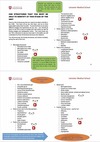Introduction the Nervous System and Topography Flashcards
(41 cards)
Which structures form the CNS?
Brain + Spinal Cord
- (structures whose embryonic precursor is the neural tube)*
- brain = cerebral hemispheres, cerebellum & brainstem*
Which structures form the peripheral nervous system?
Dorsal and Ventral Roots
Ganglia
Spinal Nerves
Peripheral Nerves
What is a ganglia in the nervous system?
a collection of cell bodies in the peripheral nervous system
What is a nuclei in the central nervous system?
a collection of cell bodies
Outline the basic relationship of grey to white matter in the brain and spinal cord
Brain
central grey matter with white matter covering, covered in addtional cortex of grey matter
Spinal Cord
central grey matter (butterfly shaped) with white matter covering

What gives the grey matter is characteristic colour?
Lack of Myelin / Fat
Highly Vascularised
Which parts of the neuronal cell is found within the:
Grey Matter
White Matter
Grey Matter
cell bodies and dendrites
White Matter
axons and supporting cells

What is the peripheral nervous system equivalent of grey amtter and white matter?
Grey Matter
ganglion - a collection of cell bodies
White Matter
peripheral nerve
At the spinal cord, ventral and dosral nerve roots arise, what is their function and what do they eventually give rise to?
Vental - motor never
Dorsal - sensory nerve
form Spinal Nerves (mixed motor and sensory)

What are the upper and lower boundaries of the spinal cord?
Upper - formaina magnum
Lower - around L1
(cord terminates at conus medullaris)

Where could you localise a lesion if a patient presents with isolated sensory deficit in a limb, rather than both motor and sensory deficit?
localised to dorsal nerve root or dorsal root ganglion

How many pairs of spinal nerves are there along the spinal cord?
31 pairs of spinal nerves
What is a funiculus?
A segment of white matter containing multiple distinct tracts

What is a tract in the spinal cord and what is an important feature of its function?
an area of anatomically and functionally defined white matter, connecting two regions of grey matter
UNIDIRECTIONAL

What is a fasiculus in the spinal cord?
a subdivision of a tract supplying a distinct region of the body
- e.g.*
- fasiculus gracilis (supplies lower half of body)*
- fasiculus cuneatus (supplies upper half of body)*

What is the relevanve of Rexed laminae when considering the action of a muscle?
Grey matter of the spinal cord is segmented in a similar fashion to the white matter
Multiple segments (or Rexed laminae) of grey matter in the spinal cord provide motor innervation to a particular muscle group
e.g. L2, L3, L4 innervate the quadriceps femoris

What is the cortex of the brain?
a folded sheet of cell bodies on the surface of the brain
A ‘fibre’ can be used synonymously with the word axon, but name the structures that form a fibre?
axon of a neurone in associaton with its supporing cells (e.g. oligodendrocytes)
What is the role of association fibres in the nervous system?
connect cortical regons within the same hemisphere

What is the role of commissural fibres in the nervous system?
connect the left and right hemispheres or cord halves
e.g. corpus callosum

What is the role of a projection fibre in the nervous system?
connect the cerebral hemisphere with the cord/brainstem
(or vice versa)

What is the functon of the midbrain?
eye movement
reflex responses to sounds and vision
What is the functon of the pons?
feeding
sleep
What is the functon of the medulla oblongata?
cardiovascular and respiratory centres
contrains major motor pathway (medullary pyramids)


















